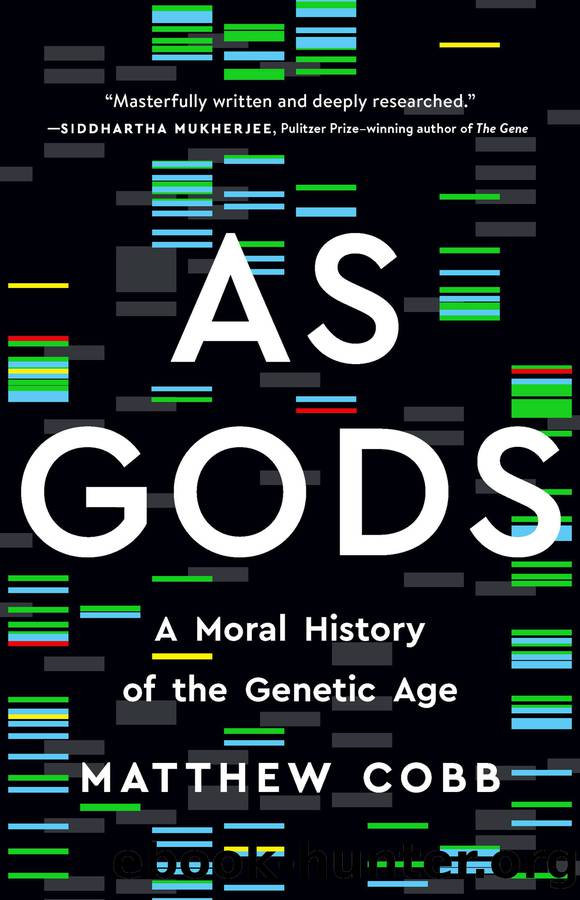As Gods by Matthew Cobb

Author:Matthew Cobb [Cobb, Matthew]
Language: eng
Format: epub
Publisher: Basic Books
Published: 2022-11-15T00:00:00+00:00
As the CRISPR acronym indicates, these repeated sequences tended to be clustered in the genome, were vaguely palindromic and were regularly interspaced with other stuff. Initially, the sole aim of Mojica and Jansen was to understand this bit of microbial genomic weirdness. That began to change in 2003, when Mojica searched the early genome databases and discovered that the DNA between the CRISPR sequences came from bacteriophage viruses, suggesting that the bacteria had acquired these sequences after viral infection â CRISPR sequences were a natural form of recombinant DNA. Mojica thought about why such sequences might be so widespread and decided that CRISPR and their accompanying interspaced bits of DNA and the Cas genes somehow represented a bacterial immune system â a way of recognising and resisting viral infection. Having gathered experimental evidence in support of this hypothesis, in autumn 2003 Mojica submitted an article to Nature describing his discovery. The editor was unimpressed and rejected the paper forthwith, claiming that all this was already known (it was not). It took two years and rejection by three more journals before the article finally appeared in the Journal of Molecular Evolution.21 Mojica was rightly frustrated by the delays â within months of this article appearing, two other groups, working on different microbes, reported similar findings.22
None of these researchers were able to show exactly what these genes did, nor how the viral DNA got into the regions between the CRISPR sequences. That was partly resolved in 2007 by a group working for Danisco, the Danish agribusiness company, led by Philippe Horvath and Rodolphe Barrangou (Danisco was interested in the phenomenon because the bacteria involved in producing yoghurt were repeatedly attacked by bacteriophages, and CRISPR might be a way of protecting them). They showed that after infection with a bacteriophage, bacterial colonies acquired new âspacerâ DNA from the virus; removing spacer DNA affected the ability of the bacteria to resist the virus.23 As Mojica had suspected four years earlier, CRISPR was involved in acquired resistance to bacteriophages.24
The following year, researchers showed that bacteria turned the viral DNA trapped in their genomes into RNA and used that sequence to guide Cas enzymes to attack invading viral nucleic acids.25 It was still unclear whether the Cas enzymes cut DNA or RNA; although most researchers suspected that the target was DNA, some favoured the idea that they blocked the activity of RNA molecules. (Craig Mello and Andrew Fire had recently won the Nobel Prize in Physiology or Medicine for their discovery of the influential RNA interference technique, which may have skewed assumptions.)
CRISPR was beginning to attract attention â there were publications in leading journals, the sequences were found throughout the microbial tree of life, which suggested that they had a major evolutionary significance, and yet the way the system worked was still unresolved. In 2008, the first CRISPR conference took place in Berkeley, attended by around thirty-five people. This might not seem very many, but Mojica, who was brought over from Spain as a keynote speaker,
Download
This site does not store any files on its server. We only index and link to content provided by other sites. Please contact the content providers to delete copyright contents if any and email us, we'll remove relevant links or contents immediately.
| Anatomy | Animals |
| Bacteriology | Biochemistry |
| Bioelectricity | Bioinformatics |
| Biology | Biophysics |
| Biotechnology | Botany |
| Ecology | Genetics |
| Paleontology | Plants |
| Taxonomic Classification | Zoology |
Sapiens: A Brief History of Humankind by Yuval Noah Harari(14254)
The Tidewater Tales by John Barth(12609)
Mastermind: How to Think Like Sherlock Holmes by Maria Konnikova(7229)
Do No Harm Stories of Life, Death and Brain Surgery by Henry Marsh(6891)
The Thirst by Nesbo Jo(6832)
Why We Sleep: Unlocking the Power of Sleep and Dreams by Matthew Walker(6618)
Life 3.0: Being Human in the Age of Artificial Intelligence by Tegmark Max(5476)
Sapiens by Yuval Noah Harari(5294)
The Longevity Diet by Valter Longo(5021)
The Body: A Guide for Occupants by Bill Bryson(4976)
The Rules Do Not Apply by Ariel Levy(4863)
The Immortal Life of Henrietta Lacks by Rebecca Skloot(4527)
Animal Frequency by Melissa Alvarez(4395)
Why We Sleep by Matthew Walker(4361)
The Hacking of the American Mind by Robert H. Lustig(4319)
Yoga Anatomy by Kaminoff Leslie(4308)
All Creatures Great and Small by James Herriot(4233)
Double Down (Diary of a Wimpy Kid Book 11) by Jeff Kinney(4208)
Embedded Programming with Modern C++ Cookbook by Igor Viarheichyk(4103)
